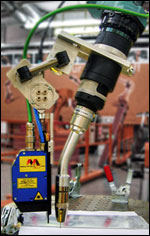Dec 28 2010
Meta Vision Systems has introduced a seam tracking system called the Smart Laser Pilot for robotic welding applications. The system uses the patented Smart Laser Sensor (SLS) that offers superior performance image processing operation within the head of the sensor itself. This enables the simplification of the entire structural design and improves the flexibility of the robotic interface.
The SLS technology incorporates a laser stripe projector, an ultra-resolution MP camera and sophisticated image processing software and hardware within a small and strong sensor head.
 Smart Laser Pilot for Robotic Welding
Smart Laser Pilot for Robotic Welding
The SLS is placed above the robot end effector’s welding torch and obtains data at 30 fps. Higher frame rates can be achieved by utilizing a windowing feature that focuses image analysis on a particular region of interest. The processing of all the images can be executed within the sensor head with a tracking precision of ±0.1 mm in both vertical and horizontal planes having a 50 mm field of view.
The SLS corresponds with the robot controller through an Ethernet link. The SLS system is provided with a breakout board comprising a laser safety circuitry, a 24 V DC power supply and an Ethernet switch. The break-out board permits the usage of one cable for both power and Ethernet between the sensor and the robot controller.
The Ethernet switch can direct the SLS signal to the robot controller or to the Vista/Windows XP/Windows 7 computer running Meta Smart Laser Pilot Tools software delivered for configuring and changing the system operating pattern. The laser safety circuit is integrated as per the requirements of international regulations to control the laser activation.
The Smart Laser Pilot can manage almost all robots that have a real-time Ethernet interface. When an Ethernet interface is not available in the robot, an Ethernet input/output board can be used for the Ethernet signals conversion. The converted signals are then sent to the robot controller through a digital/analog or serial interface.